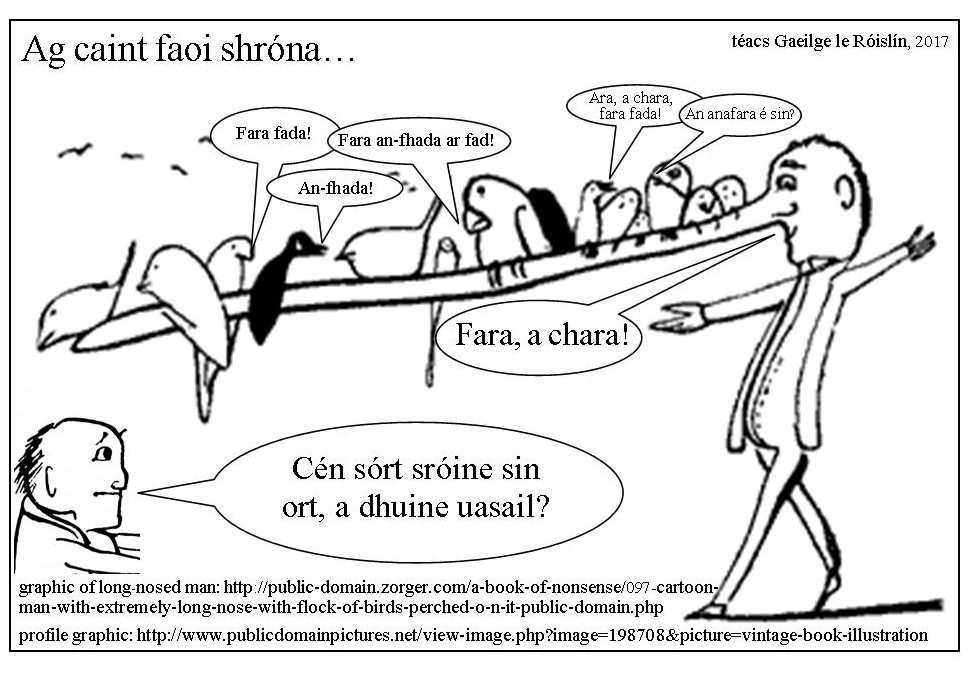Cé chomh fada is atá an tsrón? (How long is the nose?) Posted by róislín on Jun 30, 2017 in Irish Language
(le Róislín)
Last time, we looked the various forms of the word “srón” (nose) in Irish, including “sróine,” “sróna,” and “tsrón.” We also mentioned several types of noses, to be discussed in this and/or future blogs (the once and future blog?).
Today, we’ll start with the two types of noses shown in the graphic above and then work our way through the others, as far as space permits, then continue with more, soon. Which probably means it’ll be one or two more posts until we get back to pet posts like the cat face diagram (thanks btw, for the many “likes”* and nasc thíos for anyone who hasn’t read it yet), but, bíodh foighne ort, if you’re eager to say that someone is “dog-faced.”
Actually, given that there are ceithre éan déag sa phictiúr, we could just be talking about “goba” (beaks, bills, pairs of protruding lips), which, in certain combinations could also refer to a beak-nosed person (adding “siosúr” in the genitive to become “gob siosúir,” which also means “scissor-bill”, or adding a suffix, to become “gobachán“). But, since “gob” has over a dozen basic meanings in Irish, plus way many more in specialized contexts, that’ll have to wait for another posting.
So, anyway, finally, back to the graphic above. First, for the very long nose, probably I’d just say “srón an-fhada” (a very long nose). Or, somewhat less extreme, “srón fhada,” remembering that the “f” of “fada” changes to “fh” after “srón.” “Fara,” in the speech balloon above, actually means a “roost” or “perch” for birds, but, what can I say, couldn’t resist the imagery.
There is also, however, the word “socfhada,” meaning “long-nosed,” as in “gearrthóir sreinge socfhada,” which means … (freagra thíos). “Socfhada” is also used in “fíogach slim socfhada” which means … (freagra thíos freisin, ach seo leid: cineál éisc é, agus leid eile, de gnáth ní chiallaíonn “slim” i nGaeilge “slim” i mBéarla, ach ciallaíonn sé rudaí mar “sleek” agus “smooth”). “Soc” itself has a wide range of meanings, including the following: nozzle, muzzle (Remember that discussion, a “MiseÁine,” má tá tú ann fós?), snout, sharp snout (somehow, they’re distinguishable!), beak, pinched look, and projecting end (usually of a tool, vehicle, or mechanical device). So, in theory, we could say the man in the picture above is “socfhada,” but “socfhada” doesn’t really show up much as an adjective describing people.
And, not to snub non-long-nosed people, we have a couple of interesting words in Irish for “snub nose” or “snub-nosed.” Actually, the guy on the left-hand side of the picture looks less than snub-nosed to me, more like rhinotomized, ach sin definitely ábhar blag eile. For snub noses in general, we have:
caincín, snub nose, pl: caincíní. Curiously, this word is a diminutive of “cainc” which means “a prominent nose” and which gives us “cainceachán,” meaning “large-nosed person.” So the logic here seems to be “small large nose,” or, in other words, perhaps, “Little Big Nose.”
“Caincíneach,” the derived adjective, can mean “snub-nosed” or, perhaps surprisingly, “nosy,” which I would have thought pertained more to long-nosedness, i.e. stuck-in-other-people’s-business-ness. (Try that on for size, Spellchecker!).
Other words for “snub nose” include “smalán sróine” (lit. something like “stump-nose”) and “geanc.” The latter also gives us “geancach” (snub-nosed), geancachán (a snub-nosed person), and “geancóg” (a snub-nosed woman).
Well, time’s up for now. So please stay tuned for more “nose-worthy” commentary soon. Hmm, there really are people whose surname is “Noseworthy.” I wonder why. Eolas agatsa? — SGF (which for today, anyway, stands for “srón-gaosán-fara”) – Róislín
*Nóta: Hmm, is there an Irish word for Facebook-type “likes”? Can we say “*Is maith liomanna“? It feels ready to roll off the lips although it’s not exactly “de réir na gramadaí.” But then, who decided that it was legit to add a verb ending (-igí) to an adverb, as in “amachaigí” or “isteachaigí“?
After all, Shakespeare had people uncle-ing (hah, Spellchecker doesn’t like either spelling, with “e” or not) their uncles. And Lwaxana Troi complained, “Don’t you ‘Mrs. Troi’ me!” And, these days, it seems, every verb can be “nounified” (as in “ten likes” or “fifty unfollows”), and every noun can be “verbified,” as in “volumized,” for example in a weighty discussion of mascara (mascára, almost the same in Irish) and eyelashes (fabhraí). So why not go to town with improvised words?
Freagraí: gearrthóir sreinge socfhada, long-nosed wire-cutter; fíogach slim socfhada, longnose velvet dogfish
Gluais: a chara, friend (in direct address); anafara, anaphora; fara, a perch or roost (for hens, etc.)
Naisc: Aghaidheanna Cat (Faces of Cats) — Their Main Features in Irish Posted by róislín on Jun 25, 2017 in Irish Language. You might also like: Comhrá le Cat: translation, pronunciation, and glossary Posted by róislín on Jun 23, 2017 in Irish Language

Build vocabulary, practice pronunciation, and more with Transparent Language Online. Available anytime, anywhere, on any device.





Leave a comment: